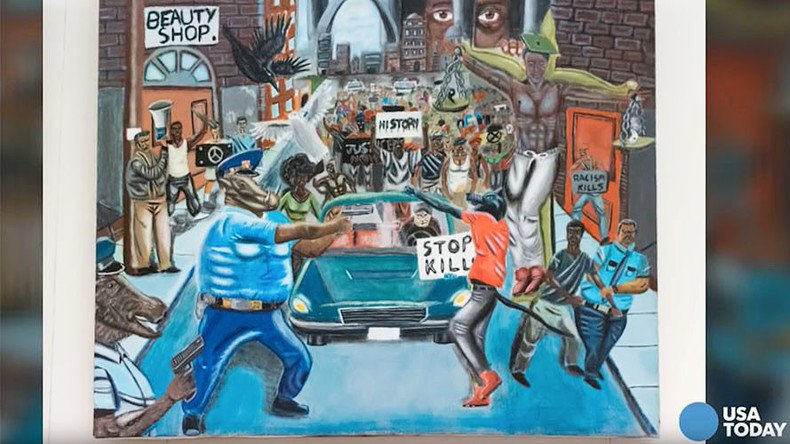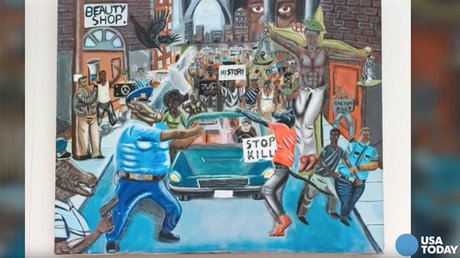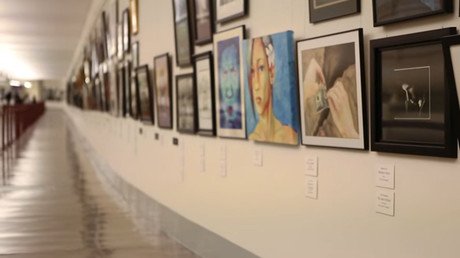Judge hogties free speech lawsuit over Ferguson cops-as-pigs painting

A federal judge has denied redemption for the removal of a US Capitol painting depicting cops as violent pigs, stating the artist’s free-speech rights were not violated when the painting was removed after protests by Republicans.
US District Court Judge John D. Bates has rejected a lawsuit filed by US Representative William Lacy Clay (D-Missouri) that sought to challenge the January removal of the controversial painting from a display of works entered into the annual Congressional Art Competition. The painting hung in a tunnel connecting the US Capitol and a US House office building for seven months before Republicans successfully lobbied for its dismissal, according to the St. Louis Post-Dispatch.
The lawsuit, filed against the Architect of the Capitol, claimed the painting's rejection violated the First Amendment rights of Clay's constituent, David Pulphus. The painting, "Untitled #1," is an interpretation of the unrest that took place following the August 2014 fatal shooting of Michael Brown, an unarmed 18-year-old black man, by police in Ferguson, Missouri. The painting depicts two police officers as pig-like animals with tusks. One is pointing a gun at a protester.
Bates ruled that the painting was susceptible to removal given the US government – Congress members in this case – chose the artworks to be displayed, set the rules for the contest, and ultimately ran the competition. Therefore, the painting was government speech and not, as the lawsuit argued, individual speech protected by the First Amendment of the US Constitution.
"There is little doubt that the removal of the painting was based on its viewpoint," Bates said.
"Although the Court is sympathetic to plaintiffs given the treatment afforded Pulphus’ art, under controlling authority this case involves government speech, and hence plaintiffs have no First Amendment rights at stake," he added.
In February, Clay sued in US District Court for the District of Columbia after the Architect of the Capitol, David Ayers, removed the painting following a formal complaint by Republicans.
Members of the Republican majority in the US House had long voiced offense at "Untitled #1" and decided the content of the artwork was a violation of the competition's rules regarding "subjects of contemporary political controversy," or of "sensationalistic or gruesome nature."
Bates also said the lawsuit did not establish the tunnel as public space.
Rules of the Congressional Art Competition "set up a hierarchy of decision-making authority with respect to content suitability: House members, by whatever method of judging they choose, select one winning piece from among the multiple works submitted to represent the district, but their choice may be overruled by the [Architect of the Capitol] if it concludes that the work does not meet the suitability guidelines," Bates said.
"In this case, Clay’s decision was overruled by the entity at the top of this decision tree, making his objections irrelevant for purposes of the government speech analysis," he added.
Clay has yet to comment on the judge's decision.
Following Clay's legal action in February, Republican Rep. Duncan Hunter, who was at the center of efforts to remove the Ferguson painting, told the Post-Dispatch that "it kind of strikes the same nerve as when the guys came home from Vietnam, and they called them baby killers," adding that Capitol Hill police officers thanked him for his actions.
Pulphus, now a college student, has only spoken of the painting via a January opinion piece published in the Post-Dispatch.
"Why would a young student with hope, promise and purpose perceive our community and the police in such a manner?" he wrote.
"The officials did not take into account the role militarization of policing has played in African-American communities (including Ferguson and St. Louis) or the way 'stop and frisk' and pretext stops invade the privacy of African-American citizens. These are things that we have personally experienced."
Discontent in Ferguson that followed Brown’s shooting – and later in the year, a grand jury decision not to indict the officer involved, Darren Wilson – was met with an aggressive militarized police response. Brown's killing set off nationwide protests of systemic racism and police violence against minority communities.















